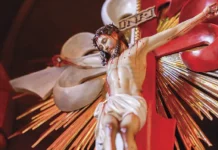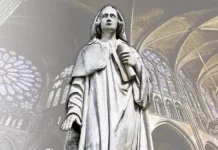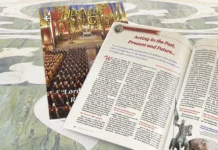Theologian, monk, author and, above all, saint. This is the profile of St. John Damascene, whose works manifest the vitality of Eastern patristic doctrine.
Located at the foot of Mount Hermon, at the edge of the Syrian Desert, Damascus is considered by scholars to be the oldest continually inhabited city in the world.
From time immemorial the city’s history has been marked by vicissitudes. Thirteen centuries before Christ, the region was a battlefield for the Hittites and Egyptians. Two hundred years later, the Aramaeans transformed it into a major city which King David later conquered, forcing it to pay him tribute (cf. 2 Sm 8:5-6). In the fourth century it was seized by Alexander the Great; after his death, the Seleucid and Ptolemaic dynasties disputed over it until it fell into Roman hands in 64 BC.
At the time of Our Lord Jesus Christ, Damascus was part of Decapolis, and shortly after His Resurrection, a group of Christians settled there. Their faith motivated Saul of Tarsus to journey to the area with the goal of persecuting them.
It was in this legendary city—an amalgamation of races and cultures—that the last of the Greek Fathers, St. John Damascene, came into the world.
Piety, beauty of expression, and purity of orthodoxy
John was born around 675 AD, into a socially prominent Arab but Christian family, when Damascus was under Muslim rule. At thirty years of age, he left the comforts of the paternal home to enter the Monastery of St. Sabas, in the Judean desert, near Jerusalem. He was soon ordained and chosen, by the Patriarch John of Jerusalem, to preach in the Anastasis (location of Jesus’ sepulchre) and in other temples of the Holy City. His doctrinal eloquence was so outstanding that he was called Chrysorrohas (golden river), which is the name of the oasis-forming waters flowing from the Anti-Lebanon mountains.
St. John Damascene superbly summarized patristic doctrine, using a beautiful style of oratory. His intellectual influence extended from East to West, where his works were studied by St. Thomas Aquinas and the scholastics. He vigorously fought the errors of the iconoclasts, but his homilies and writings also refute many other heresies that ravaged the Christian communities of his time.
Having reached a venerable age—an estimated 74 years—he surrendered his soul to God in 749, likely on December 4. Pope Leo XIII declared him Doctor of the Church on August 19, 1890.
St. John Damascene had the rare ability of combining piety, literary beauty and the purest doctrinal orthodoxy. With extraordinary talent, he united Verum, Bonum and Pulchrum (Truth, Goodness and Beauty) in an accessible language that captivated while teaching the most sublime truths about Our Lord and His most holy Mother.
The work of this Father of the Church is so extensive, and his writings so rich in masterful expositions on theological, Christological, apologetic, pastoral and Mariological topics, that it is difficult to choose a few illustrative examples from among them.
Solid Christological doctrine
With theologically precise terminology, the homilies of St. John Damascene praise the mysteries of Our Lord, while refuting the then widespread Christological errors. Affirming the complete union of the Word Incarnate with God the Father and God the Holy Spirit, he discredited Monophysitism, which proposed that the human nature of Christ was absorbed by the divinity; Nestorianism, which considered Our Lord to be a human person in which the Word was established as in a dwelling place, without in fact His assuming human nature; and Monothelitism which denies the existence of Christ’s human will.
Thus, for example, in his homily on the Transfiguration of the Lord, he echoes the anti-Monophysite teachings of the Council of Chalcedon, held in 451: “How is it possible that incommunicable things are united and yet remain distinct? How can incompatible elements become one without losing the characteristics proper to their nature? This is exactly what occurs in the hypostatic union, in such a way that the joined elements form only one being and one person, while maintaining the personal unity and the duplicity of natures, in a indivisible diversity and a unity without confusion, which takes place by means of the Incarnation of the immutable Word and the incomprehensible and definitive divinization of mortal flesh. As a consequence of this exchange, of this reciprocal communication without confusion and perfect hypostatic union, the human attributes come to belong to God and the divine attributes come to be possessed by a man. Indeed, He is truly only one, He who being God from all eternity, afterwards became man.” 1
With equal faith and theological insight, the saint of Damascus did not flinch before a theme rarely approached by earlier theologians: what happened with the soul of Christ after His death? Did the divinity separate itself from the human soul and body of the Lord?
He explains: “Although the holy and divine soul had separated itself from the undefiled and life-giving body, the divinity of the Word did not separate itself from either of these two elements, that is, neither from the body nor the soul, in consequence of the undivided hypostatic union between the two natures, which came about with the conception in the womb of the Blessed Virgin Mary, Mother of God. As a consequence, even in death, there continued to be in Christ only one person, which is the divine Word, and after the death of the Lord, the soul and body continued to subsist in this person.” 2

Homilies on Our Lady
No less magnificent are the homilies of Damascene on Our Lady. They demonstrate that devotion to the Blessed Virgin has its roots in the very beginnings of Christianity. Love for her was in evidence during the time of St. Ignatius of Antioch (a disciple of the Apostle John), St. Justin Martyr (who died in 165) and St. Irenaeus (who died in 202).
These homilies provide doctrinal elements which, centuries later, would favour the proclamation of various Marian dogmas, such as that of the Immaculate Conception and the Assumption of the Blessed Virgin Mary, body and soul, into Heaven.
In addition to their theological insight, they also manifested the author’s enthusiasm and love for the holy Virgin. “La raison parle, mais l’amour chante” (reason speaks, but love sings), declared novelist Alfred de Vigny. In St. John Damascene, reason dissertates and love sings, in treating of her who was found worthy to be the Mother of the Redeemer.
He intones praises to the perpetual virginity of Mary in these terms: “Oh Joachim and Anne, blessed and truly blameless couple! You led a life pleasing to God and worthy of her of whom you would be parents. Having lived in purity and holiness, you begot the jewel of virginity; namely, she who was virgin before, during and after giving birth. She who is the Virgin par excellence, always virgin, a perpetual virgin in mind, soul and body.” 3
And with great literary beauty, making use of images taken from the Old Testament, he teaches that Mary is the Mother of God: “The burning bush was a figure of thee, and the tablets of the law, and the ark of the covenant. The golden urn and candelabra, the table and the flowering rod of Aaron were significant types of thee. From thee arose the splendour of the Godhead, the eternal Word of the Father, the most sweet and heavenly Manna, the sacred Name above every name, the Light which was from the beginning. The heavenly Bread of Life, the Fruit without seed, took flesh of thee.” 4
This ability to unite doctrine, poetry and fervour, is a model of what Urs Von Balthasar calls theology practiced “on bent knee,” as opposed to the “office theology,” so common today. 5
Herald of the dogma of the Assumption
St. John Damascene shares the opinion generally held among the Holy Fathers of the intimate relationship between the perpetual virginity of Mary and the incorruptibility of her virginal body after death. Indeed, in passages like the following one, he anticipates the dogma of the Assumption of Mary into Heaven, body and soul.
“It was fitting that she, who had kept her virginity intact in childbirth, should keep her own body free from all corruption even after death. It was fitting that she, who had carried the Creator as a child at her breast, should dwell in the divine tabernacles. […] It was fitting that God’s Mother should possess what belongs to her Son, and that she should be honoured by every creature as the Mother and as the handmaid of God.” 6
This passage of Damascene was reproduced verbatum by Pius XII in defining the Dogma of the Assumption, in the Apostolic Constitution Munificentissimus Deus. Therein the Pope also praises the “powerful eloquence” of this saint “as an outstanding herald of this traditional truth.” 7
“St. Thomas of the Orient”
St. John Damascene said of himself that he possessed nothing original, but that he merely compiled passages from the ancient writers. Nevertheless, the light of his thought shone through the centuries and even today illuminates the horizons of theological studies.
Pope Benedict XVI, making him the subject of the General Audience of May 6, 2009, emphasized the originality of his argumentation in defence of the veneration of statues and relics of the saints and describes him as a “personage of prime importance in the history of Byzantine Theology, a great Doctor in the history of the Universal Church.”
St. John Damascene has been fittingly called “the St. Thomas of the Orient,” an apt comparison of these two luminaries of the Church from the elevated standpoint of their mutual brilliance, as much or more for their holiness of life than their knowledge. Of them it can truly be said: “When love enlivens the prayerful dimension of theology, knowledge, acquired by reason, is broadened. Truth is sought with humility, received with wonder and gratitude: in a word, knowledge only grows when truth is loved. Love becomes intelligence and authentic theology becomes wisdom of the heart, which directs and sustains the faith and life of believers.” 8 ◊
Mary’s “Departure” for Heaven

What, then, shall we call this mystery of thine? Death? […]
The body of her, whose virginity remained unspotted in child-birth, was preserved in its incorruption, and was taken to a better, diviner place, where death is not, but eternal life. […] Therefore I will not call thy sacred transformation death, but rest or going home, and it is more truly a going home. Putting off corporeal things, thou dwellest in a happier state.
Angels and archangels bear thee up. Impure spirits trembled at thy departure. The air raises a hymn of praise at thy passage, and the atmosphere is purified. Heaven receives thy soul with joy. […]
Thou were not taken into heaven as Elias was, nor did thou penetrate to the third heaven with Paul, but thou did reach the royal throne itself of thy Son, seeing it with thy own eyes, standing by it in joy and unspeakable familiarity.
(ST. JOHN DAMASCENE. On holy images, followed by three sermons on the Assumption.
Translated by Mary H. Allies. London: Thomas Barker, 1898, p. 164).
Notes
1 ST. JOHN DAMASCENE. Homily on the Transfiguration. Translation of: Homilía sobre la Transfiguración. In: PONS, Guillermo (Intr. e notas). Homilías Cristológicas y Marianas. Madrid: Ciudad Nueva, 1996, p.24.
2 ST. JOHN DAMASCENE.Homily on Holy Saturday. Translation of: Homilía sobre el Sábado Santo. In: Op. cit., p.103.
3 ST. JOHN DAMASCENE. Homilía sobre la Natividad. In: Op. cit., p.125.
4 ST. JOHN DAMASCENE. Three sermons on the Assumption. Tr. Mary H. Allies. London: Thomas Barker, 1898 p.160, 161.
5 Cf. BENEDICT XVI. Speech to the monks gathered in the Abbey of Heiligenkreuz, 9/9/2007.
6 Cf. Munificentissimus Deus, 1/11/1950.
7 Idem, ibidem.
8 General Audience of 28/10/2009.







